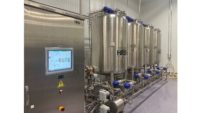Tech | Ingredients
Considerations for hydrocolloids reformulation

Ingredient technology to produce clean-label products that meet quality expectations is leading development in gums, binders and other emulsifiers. Additionally, use of gums, binders and emulsifiers to make plant-protein-based meat analogs more similar to meat products continues to progress, says Wes Schilling, professor of food science at Mississippi State University.
Label-friendly ingredients — even in this ingredient category, in which many are derived from plant materials — is where development is happening, says Edward Mills, associate professor of meat science at Penn State University, in University Park, Pa. For example, pea protein, which has been around for a while, is still finding different uses. Because it is a protein, it has the potential to be an emulsifier in certain circumstances. The protein structure is such that pea protein is not a good emulsifier for pork or beef fat, but possibly well suited for poultry products where the fat has a lower melting point, Mills explains.
It is harder to make lean products such as deli meats without gums, binders and other emulsifiers, Schilling adds. “It is also harder to make deli meats that are thinly sliced,” he says. “Ironically, it is also harder to make meat analogs without these ingredients. It is also harder to make deli meat type and emulsion products that contain a high concentration of water.”
Some other issues include dispersion of the gum in the brine so that it is functional, Schilling says. Additionally, making sure that processing is done correctly so that gums are part of the product and do not form gel pockets remains a concern.
Meat and poultry products have a need for gums, binders and other emulsifiers that can contribute to gel formation and water retention, but distributing them evenly through a solid muscle product is very difficult.
“In low-fat meat products, fat reduction often leads to unacceptable, tough textures,” says Kantha Shelke, principal of Corvus Blue, in Chicago. “When the appropriate gums, binders and other emulsifiers are incorporated in these formulations, they improve the textural characteristics of the product by decreasing toughness and increasing juiciness.”
Consumer demands
Consumer pushback against prevailing gums, binders and other emulsifiers also has led to the unsubstantiated preference of one type of hydrocolloid over another and to the unsupported approach of reducing the number of ingredients as if this were a healthier approach to food production, Shelke says. No single nature-based hydrocolloid can accomplish the work of two or three, especially in the meat and poultry industry, because of the range of functionalities they provide.
“This is an even taller order for those seeking plant-based hydrocolloids because by nature, phytochemicals tend to have a distinct grassy or signature like taste or aroma that is integral to their function in nature and which are a turnoff for consumers in the Western world who have a rather limited palate,” she says.
Right now, certain starches also get consumer resistance because they don’t qualify for the gluten-free label, so processors are turning to potato or rice starch. Mills cautions the effect of diverse grain starch species can be quite different.
Another issue is that although hydrocolloids like carrageenan, alginates and others have been studied extensively, the mechanism by which they interact with meat proteins and the other meat components is still not fully understood.
“A number of new sources of hydrocolloids are emerging in natural products or by-product streams,” Shelke says.
Traditional hydrocolloids used in muscle foods include modified starch, carrageenan, konjac glucomannan and alginate, all of which are derived from plants. Newer sources for hydrocolloid ingredients include gums from fermentation, such as xanthan, gellan, bacterial celluloses, curdlan or dextran along with from cereals and hemicellulose, including β-glucans, arabinoxylans and xyloglucans. Additionally, agricultural byproducts such as soluble soybean polysaccharide from okra, flaxseed gum, yellow mustard gum, psyllium, tara gum, fenugreek and corn fiber gum are being developed.
Ingredient companies also continue development of cultured carrageenan, citrus fibers, other fibers, konjac, xanthan gum, locust bean gum and guar gum, Schilling says.
Gelatin and collagen are animal-based hydrocolloids that are popular with meat and poultry processors, but they do not offer the range of functionalities associated with plant-based hydrocolloids. “Efforts to derive materials with such functionalities from animal byproduct streams are thwarted by the squeamishness of Western consumers who relish muscle foods but are turned off from byproduct derivatives from meat and poultry processing,” Shelke says.
Moving forward, a challenge for hydrocolloids will be the demand for natural, clean-label ingredients. While most of the prevailing hydrocolloids are from a natural stock, many more are extracted or modified by industrial means that do not meet clean-label perceptions, Shelke says. NP
Looking for a reprint of this article?
From high-res PDFs to custom plaques, order your copy today!










